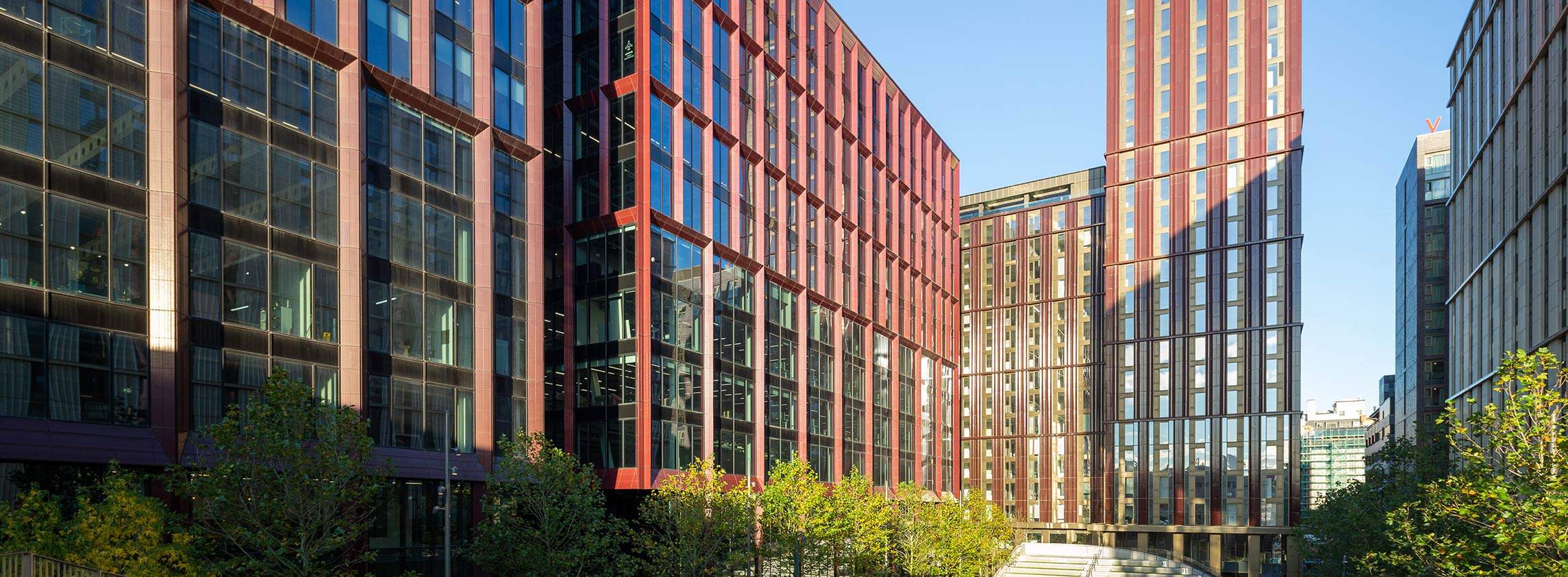We focus on the current Manchester office market and share insights from three different organisations and their varied experiences in navigating new office space
Top takeaways for the post-pandemic office:
- Office greenery
Plants have a powerful ability to lower temperatures in cities, as well as make buildings more habitable through noise reduction, air filtration and creating attractive places. They are also crucial for improving the UK’s biodiversity.
- Breakout spaces
One of the best ways to increase well-being and give your employees a chance to unwind is with breakout spaces. Bringing them in means employees won’t eat their lunch at their desks and will be able to enjoy a break from screen time.
- Flexibility/collaboration
There is an increased desire for workplaces that incorporate flexibility, collaboration and amenity to attract ‘future’ talent. Office buildings can do more than just provide a space to work; they can bring people together. The best and most efficient way to promote such social behaviour within your building is by adding communal spaces in it.
- People that use the space
Employees must become part of the conversation; they must feel involved in the decisions in how their workspace looks, feels and is used. Research has constantly shown that increased autonomy – or even the perception of an increase in control – can improve how people feel. As a result, successful buildings empower their users and allow them to use space in a way that suits their personal needs.
- Return to the office
As employees return to the office, the biggest impact on city centre requirements will be the way in which floor space is used. Rather than having an office that has typically focussed on desk space, offices that offer ’burst space’, such as business lounges and additional meeting rooms, are receiving the most interest. This type of space is becoming a necessity for team meetings or ’overspill’ for days when more people come into the office.
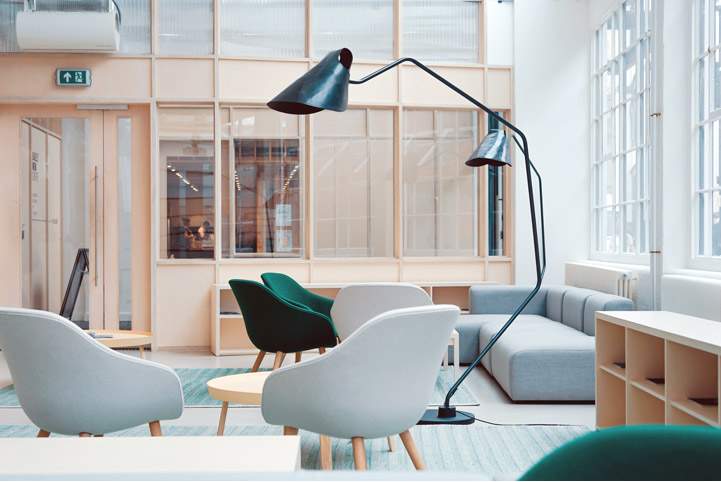
Demand for high-quality regional offices has grown significantly over the last decade, with 78% of deals over 50,000 sq ft since 2017 being Grade A.
With offices now being used as a recruitment tool and a key feature in the race for talent, occupiers are willing to pay premium rents for the best space, and as conversations around the future of the workplace continue, it is unsurprising that the sustainability credentials of offices are becoming increasingly pertinent.
Savills latest Office FiT survey found that although the office remains important, so does its configuration. Additional work settings, collaborative spaces and virtual communications must all be taken into account.
A well-designed, sized, and located workplace creates a positive ripple effect, reducing sick leave and increasing productivity and, in turn, helps drive employment, improve amenity and even encourage business generation. According to a recent Gallup-Healthways poll, millennials are 81% less likely to move jobs in the next year if their employer focuses on employee wellbeing.
Workplace wellbeing is especially vital to staff retention post-Covid. With individuals returning to the office and new ways of working, it’s even more important that employers look at how workspaces can foster culture and connection.
Covid-19 has made healthy and sustainable buildings mainstream, with occupiers imagining space in an entirely new way, recognising how we work now is very different from even the recent past, and the future of work is changing rapidly.
The idea that a building can have a far-reaching impact on a community is pivotal and widely recognised by assessment methods such as GRESB and BREEAM.
Companies who adopt the 'wellness generation' view will be much more successful in attracting, retaining and engaging talent
Clare Bailey, Director, Commercial Research
The pandemic has undoubtedly made us even more aware of the environment we live and work in and particularly the quality of the air we breathe. In fact, as it becomes easier and cheaper to monitor, record and give occupants feedback on environmental information such as temperature, air quality or water purity, this is starting to become more commonplace. There is also a greater advancement in workplace lighting, such as circadian systems, which are more closely aligned to the changes in the sunlight throughout the day as seen at Bruntwood’s 111 Piccadilly, which uses this new ’circadian’ lighting system – designed to replicate a 24-hour cycle of sleep, wake, hunger, alertness, and body temperature – combined with the use of planting and greenery in biophilic design.
Workplace culture has also been demonstrably linked to better financial performance, innovation, talent attraction, ethical workplace behaviour, and customer satisfaction. While a decade ago there were few studies able to draw this data-driven conclusion, today there are hundreds – an overwhelming intellectual shift that has changed the minds of CEOs about the deep impact of company culture on businesses.
Companies who adopt this ’wellness generation’ view will be much more successful in attracting, retaining and engaging the most powerful generation in the workforce today. A workplace that leans towards flexibility, collaboration and culture to attract ‘future’ talent is key. The people that use the space must become part of the conversation – feeling involved in the decisions made on how their workspace looks, feels and is used.
The post-pandemic workplace
Cundall, Fourways House, Manchester
Cundall moved offices in August 2021, and it is now located in the Grade II listed Fourways House in Manchester’s Northern Quarter.
The move was initiated in the summer of 2020 when Cundall staff were all working from home due to the ongoing Covid-19 pandemic. Whilst always committed to maintaining a base in the city, the challenges posed by the pandemic allowed Cundall to review what was needed from a post-pandemic office.
Extensive staff consultation was carried out in 2020 on a number of key aspects of the brief, including a requirement for the landlord to guarantee the availability of renewable electricity procurement (this was non-negotiable for Cundall as it formed part of its carbon-neutral certification, which was achieved through the Carbon Trust in September 2020).
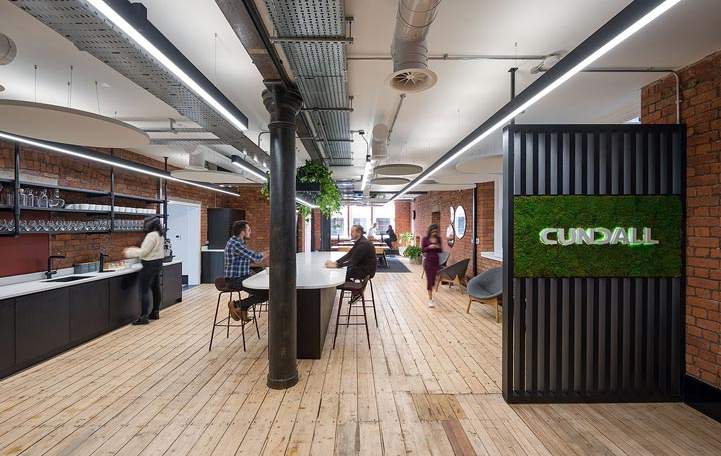
Cundall, Fourways House, Manchester
Anecdotal staff feedback received indicated a strong preference for a building with opening windows rather than a mechanically ventilated space with a sealed façade. Fourways House is located in a quiet part of the city centre, which allows Cundall to maximise use of natural ventilation when external temperatures allow it. The pandemic had placed even more onus on the need for good showers and changing facilities and bike storage provision to promote active travel and healthy lifestyles.
AEW Architects, Trinity, Manchester
In July 2021, AEW Architects announced their relocation to the seventh floor (5,588 sq ft) of the recently refurbished Trinity building. The relocation came at the right time, enabling AEW to consider its office requirements in response to the change in the ways of working brought about by Covid-19. At Trinity Manchester, AEW designed a flexible, collaborative new office for its employees, which embodies its commitment to wellbeing and sets a new standard for the post-pandemic workplace.
AEW had fully embraced hybrid home/office working, seeing this as not just a temporary fix, but a long-term shift to offer a better work/life balance for its employees – the new office needed to reflect this.
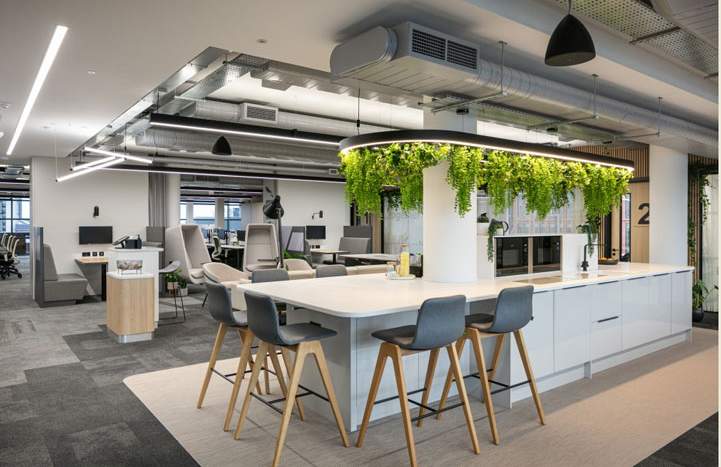
AEW Architects, Trinity, Manchester
AEW worked closely with its staff to understand what its future work environment would look like and to identify the key functions of the new workplace. The company reduced its overall office size and focussed on designing a flexible, collaborative space that champions its ’Together we’ culture. The space was designed with a light, fresh and contemporary palette to optimise natural light and cityscape views. The number of traditional fixed workstations was reduced and replaced with a range of formal and informal workspaces. AEW also invested significantly in technology-enabled, future-proofed workplace infrastructure to support individual and collaborative work for the team and its clients across the office and remote locations.
Bosch, No.2 Circle Square, Manchester
Bosch moved to No. 2 Circle Square from Cheadle Heath in Stockport, where the workspace no longer suited their requirements. They were also keen to tap into the future young talent pool and build relationships with the universities.
Bosch immediately recognised Bruntwood’s vision for Circle Square, which focuses on collaboration with other tenants within a part of the city that will become known for its innovation. Circle Square is the epicentre of a new collaborative community, at the heart of Oxford Road Corridor, Manchester’s innovation district, surrounded by knowledge institutions and cultural hotspots.
One of Bosch’s key requirements was for its workspace to incorporate flexibility, collaboration and amenity to attract talent while also co-locating with other similar businesses, talent pools and knowledge hubs. Circle Square ticked all those boxes – it offered a completely different concept, something totally new.
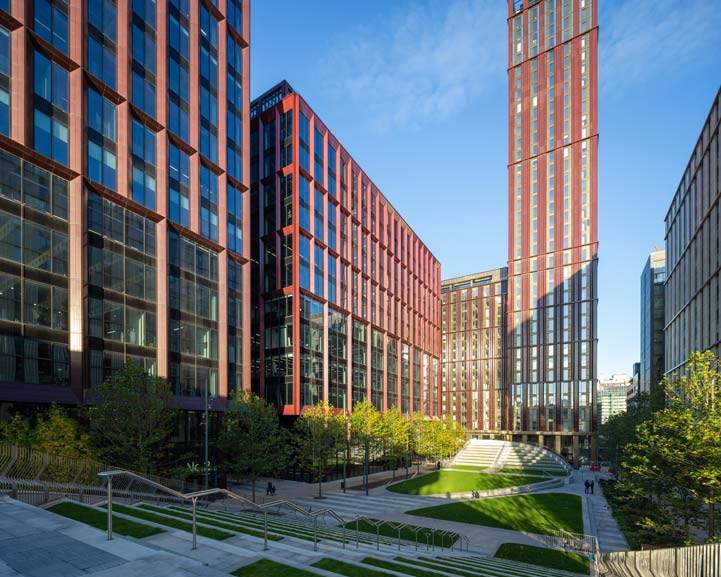
Circle Square, Manchester
Bosch realised that office buildings can do more than just provide a space to work – they can bring people together. The best and most efficient way to promote such social behaviour within buildings is by adding communal spaces. The flexible space offered in Circle Square enabled Bosch to downsize to 10,000 sq ft while actually gaining more community and amenity space.
Symphony Park and its event space added something particularly special to the scheme. Symphony Park is in the centre of the neighbourhood and is a significant new public space – it has two large green lawns and terraces surrounded by more than 100 trees. The terraces climb to provide informal seating or an amphitheatre for live music and theatre performances.
Bruntwood is the UK’s first commercial property landlord to sign up to the World Green Building Council’s Net Zero Carbon Buildings Commitment, including its whole life carbon requirements and pledge its buildings are net zero carbon by 2030 – which aligns with Bosch’s vision. Bosch’s previous premises offered a number of car parking spaces, which seemed out of touch with the younger workforce’s push for more sustainable travel. Circle Square, however, offers excellent transport links and a host of bike storage and shower facilities to promote healthy lifestyles amongst the staff.
How affordable workspace is nurturing creative talent
Providing affordable and interesting workspaces is crucial to ensuring that cities such as Manchester are at the forefront of the tech and creative industries, and therefore a draw for national and international talent.
Bruntwood SciTech’s Circle Square in Manchester is a great example of space that offers flexible workspaces and bespoke programmes of business support, helping creative, digital and technology businesses to form, scale and grow.
Located at Circle Square is Bruntwood SciTech’s dedicated Tech Incubator, which is home to a unique cluster of some of the region’s most disruptive, fast-growing tech businesses. From sharing knowledge and resources to brainstorming ideas and broadening networks, collaboration can vastly improve an SME’s growth prospects, and increased affordable accommodation for startups to collaborate alongside established tech companies helps them to develop, innovate and grow. According to the Blair Project, which is based in the Tech Incubator, some of the major benefits to being located there are: “having access to specialist industry workshops and clinics to grow our knowledge, connections and skillsets to scale our business and commercial acumen is fantastic".
